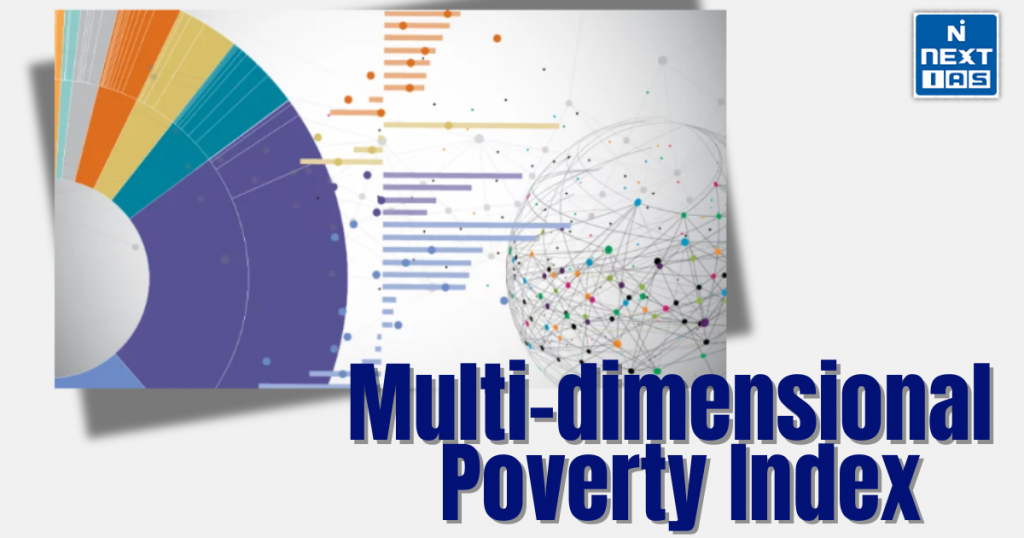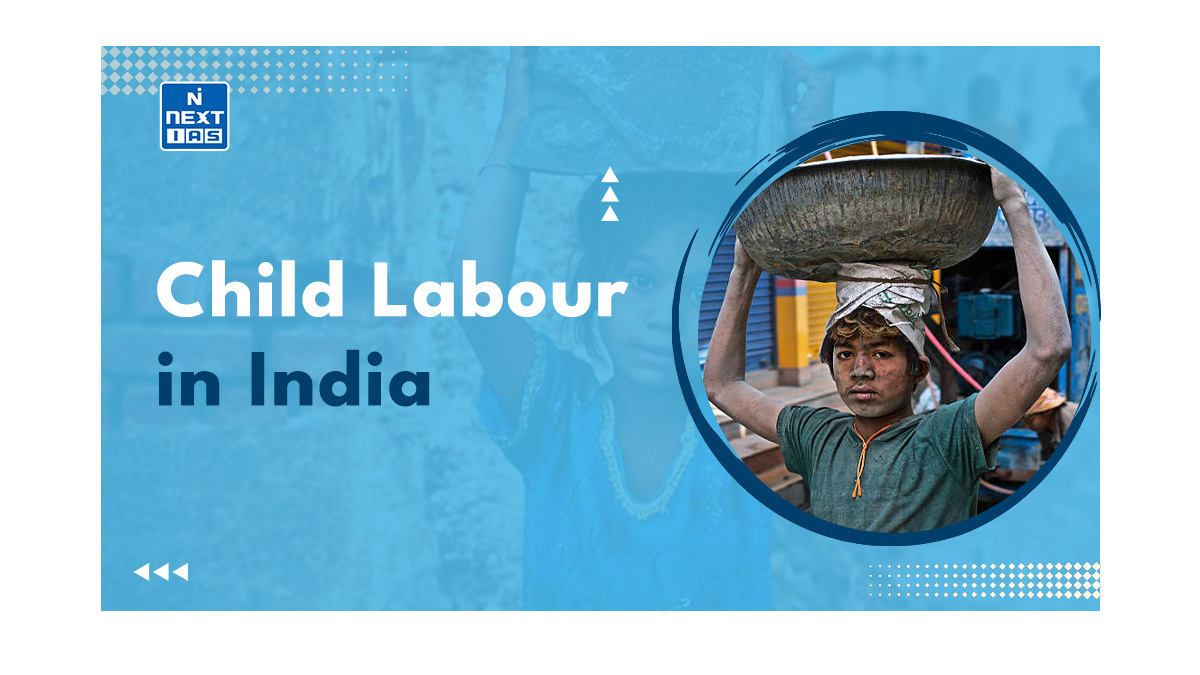
Multidimensional Poverty Index (MPI) is a measure that assesses acute poverty in over 100 developing countries. It goes beyond just looking at monetary poverty and considers the simultaneous deprivations in health, education, and living standards that people face.
Dimensions, Indicators & Calculations of Multidimensional Poverty Index (MPI)
It looks at poverty at an individual level. If a person is deprived in at least one-third of ten indicators, they are considered “MPI poor”. The severity of their poverty is determined by the percentage of deprivation they experience.
- The global MPI provides a comprehensive understanding of who is poor and how they are poor.
- It allows for comparisons across countries and regions, as well as within countries based on factors like ethnic groups, urban/rural areas, subnational regions, and age groups.
- The composition of MPI by each of the ten indicators helps to reveal specific aspects of poverty.
- It is a valuable tool for policymakers as it helps identify the most vulnerable individuals and enables them to target resources and design effective policies.
- It was developed by OPHI in collaboration with the UN Development Programme (UNDP) and has been published annually in the Human Development Report since 2010.
- The MPI measures poverty using three dimensions: health, education, and standard of living.
- These dimensions are further broken down into ten indicators, including child mortality, nutrition, years of schooling, school attendance, cooking fuel, sanitation, drinking water, electricity, housing, and assets.
Facts and Figures from Multidimensional Poverty Index (MPI) Report
According to the Global Multidimensional Poverty Index (MPI) Report 2022, an estimated 1.2 billion people worldwide are living in multidimensional poverty. Of these, 518 million people are classified as severely poor.
- Children under 18 make up half of the poor population, while nearly one in three children live in poverty.
- Additionally, South Asia and Sub-Saharan Africa have the highest number of impoverished individuals, with the majority residing in rural areas.
- The report also highlights that certain indicators, such as food, cooking utensils, toilets, and housing, reveal significant deprivation among the poor, particularly in South Asia.
- India has the largest population of poor people, followed by Nigeria, and a significant proportion of them lack access to food.
- Regarding poverty reduction, the report shows that out of 81 countries with trend data, 72 have seen a statistically significant decrease in their MPI values. In about 26 countries, every index of deprivation has decreased significantly.
Multidimensional Poverty Index (MPI) India Report
Reduction in Poverty
- The poverty rate in the country went down from 55.1% in 2005/06 to 16.4% in 2019/21. All ten indicators used to measure poverty showed significant improvements, leading to more than a halving of the poverty level. In India, 415 million people were able to escape poverty over a span of 15 years from 2005 to 2021.
- The reduction in poverty in South Asia is mainly due to improvements in India’s situation.
Relative Reduction in Poverty
- Comparing the years 2015/2016 to 2019/2021, the poverty rate dropped at a faster rate: 11.9% each year compared to 8.1% from 2005/2006 to 2015/2016.
Performance of States
- In terms of absolute improvement, Bihar, the poorest state in 2015–16, experienced the fastest decrease in the MPI value. Bihar’s poverty rate dropped from 77.4% in 2005–2006 to 52.4% in 2015–2016, and further down to 34.7% in 2019–21.
- Only one state (West Bengal) that was among the poorest in 2015–2016 remains on the list in 2019–21.
- The other states (Bihar, Jharkhand, Meghalaya, Madhya Pradesh, Uttar Pradesh, Assam, Odisha, Chhattisgarh, and Rajasthan) continue to rank among the bottom ten in terms of poverty.
- Among Indian states and union territories, Goa experienced the fastest relative decline, followed by Jammu & Kashmir, Andhra Pradesh, Chhattisgarh, and Rajasthan.
Poverty Among Children
- Although India still has the highest percentage of poor children in the world, child poverty decreased at a faster rate in absolute terms. In India, more than one in five children and about one in seven adults live in poverty.
Reduction of Poverty Region Wise
- In rural areas, the poverty rate decreased from 36.6% in 2015–2016 to 21.2% in 2019–2021, and in urban areas, it decreased from 9.0% to 5.5%.
Significance of the Multidimensional Poverty Index
- MPI helps create a complete picture of poverty by identifying who is poor and how they are poor.
- It allows for comparisons between countries and regions and within countries among different groups, such as urban and rural areas.
- MPI is flexible and can be adapted to different contexts, maintaining transparency in identifying the poor.
- It helps prioritize efforts to target the most vulnerable, works at different levels (individual, agency, community), and allows for comparisons against specific cutoffs in each dimension.
- MPI simplifies measurements by breaking them down into dimensions to identify the main contributors to multidimensional poverty.
Limitations of the Multidimensional Poverty Index
- Poverty is a complex issue with many factors, making it difficult to address all aspects.
- Gathering data for multidimensional indicators can be challenging.
- The large number of indicators can be overwhelming and lead to ineffective implementation.
- MPI does not capture intra-household inequality or inequality among the poor.
- It is also challenging to determine which dimensions are relevant and how many should be considered or prioritized.
FAQs
Who publishes Multidimensional Poverty Index?
The MPI is published by the Oxford Poverty and Human Development Initiative (OPHI) in collaboration with the United Nations Development Programme (UNDP).
What is the Multidimensional Poverty Index?
The MPI is a measure that goes beyond income-based poverty and assesses poverty based on deprivations in various dimensions of well-being. It takes into account factors such as health, education, and living standards, providing a more comprehensive understanding of poverty.
What is the Rank of India in the Global Multidimensional Poverty Index?
The rank of India in the Global MPI varies depending on the year. In the most recent data available, India has a significant number of people living in multidimensional poverty. In 2021 MPI rank in India was 66.
What are the 10 Indicators of Poverty?
The ten indicators of poverty used in the MPI include child mortality, nutrition, years of schooling, school attendance, cooking fuel, sanitation, drinking water, electricity, housing, and assets. These indicators collectively capture different aspects of poverty and deprivation across multiple dimensions of well-being.





